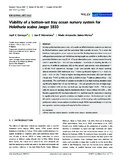Viability of a bottom-set tray ocean nursery system for Holothuria scabra Jaeger 1833

View/
Request this document
Date
2017Page views
286Metadata
Show full item recordCited times in Scopus
Share
Abstract
Scaling up the hatchery production of juvenile sandfish Holothuria scabra is constrained by limited hatchery space and the associated high operational costs. To shorten the hatchery rearing phase, ocean nursery systems like floating hapa nets have been used with good prospects but with limitations during rough sea conditions. In this study, the potential of bottom‐set trays (0.14 m2) as an alternative ocean nursery system for early sandfish juveniles (0.5 ± 0.1 cm) was evaluated. The effects of stocking density and presence of artificial substrates (AS) on the growth and survival were determined in a 60‐day field experiment. Average length and growth rates at lower stocking density treatment (100 individuals tray-1) were significantly higher (1.45 ± 0.22 cm; 0.03 ± 0.01 cm day-1) than at higher stocking density treatments (400 and 500 individuals tray-1) 0.95 ± 0.06 cm; 0.03 ± 0.004 cm day-1) with or without AS (p < .05) respectively. The coefficient of variation in length (CV) at high stocking densities were significantly higher than at low densities (p < .05) and growth rate was strongly negatively correlated with density. Survival was significantly higher (55% ± 9%) in trays with AS across all stocking density treatments than in trays without AS (34% ± 2%). Results suggest that AS may have reduced intra‐ and interspecific interactions, resulting to significantly lower growth variations and higher survival. The bottom‐set tray with AS can be a practical alternative ocean nursery unit for rearing early sandfish juveniles particularly when the sea surface condition is rough. With improved design and density management, survival and growth may be further enhanced.
Suggested Citation
Gorospe, J. R. C., Altamirano, J., & Juinio-Meñez, M. A. (2017). Viability of a bottom-set tray ocean nursery system for Holothuria scabra Jaeger 1833. Aquaculture Research , 48(12), 5984-5992. https://doi.org/10.1111/are.13423
Subject
interspecific relationships  ; growth rate
; growth rate  ; substrata
; substrata  ; stocking (organisms)
; stocking (organisms)  ; juveniles
; juveniles  ; survival
; survival  ; tray culture
; tray culture  ; costs
; costs  ; rearing techniques
; rearing techniques  ; sea surface
; sea surface  ; operating costs
; operating costs  ; nursery grounds
; nursery grounds  ; density
; density  ; interactions
; interactions  ; scaling; hatcheries; floating
; scaling; hatcheries; floating  ; stocking density
; stocking density  ; sea cucumbers
; sea cucumbers  ; Holothuria scabra
; Holothuria scabra  ; viability
; viability 
 ; growth rate
; growth rate  ; substrata
; substrata  ; stocking (organisms)
; stocking (organisms)  ; juveniles
; juveniles  ; survival
; survival  ; tray culture
; tray culture  ; costs
; costs  ; rearing techniques
; rearing techniques  ; sea surface
; sea surface  ; operating costs
; operating costs  ; nursery grounds
; nursery grounds  ; density
; density  ; interactions
; interactions  ; scaling; hatcheries; floating
; scaling; hatcheries; floating  ; stocking density
; stocking density  ; sea cucumbers
; sea cucumbers  ; Holothuria scabra
; Holothuria scabra  ; viability
; viability 
Collections
- AQD Journal Articles [1222]
